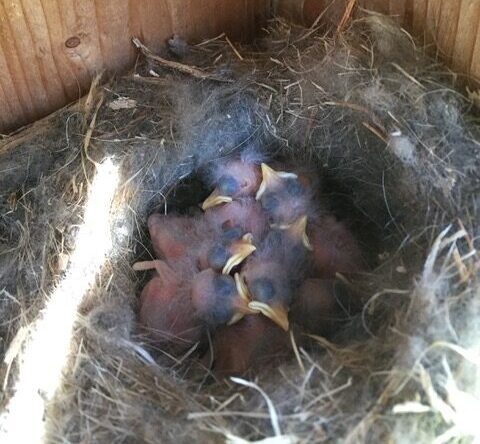Volunteer and long-time birder, Stan Wakefield, shares regular updates and pictures on bird nesting activity at BRLT’s bird boxes monitored at Oak Point Farm, Singing Meadows, Lobster Cove Meadow, Penny Lake, and Zak preserves. Data is also reported to NestWatch, a citizen-science monitoring program developed by the Cornell Lab of Ornithology and used nationwide to track the status and trends in the reproductive biology of birds. We encourage readers to check back frequently from April-August to keep up on all of the changes throughout the season.
——————————————————————————————————————-
The bluebird and tree swallow breeding season on five monitored Land Trust preserves has come to an end. While it was generally successful, it was a bit different from previous nesting seasons.
Singing Meadows, with six nest boxes, produced the lion’s share of new bluebirds with forty-four youngsters fledged. Four of the six boxes had two successful broods each while one had a single successful brood. Of note, tree swallows did not use any of the Singing Meadows nest boxes this year, which is a first.
Two of Zak preserve’s nest boxes were responsible for ten new bluebirds from three broods. A fourth brood failed for unknown reasons. The third nest box was used by tree swallows with six youngsters fledging successfully.
Penny Lake’s three nest boxes had mixed success this year. Tree swallows used two of the boxes with only five young successfully fledged. The other nest box had two broods of five eggs each, none of which survived. We’re uncertain why this mortality occurred. The third Penny Lake nest box produced nine new bluebirds from two broods.
Oak Point Farm has five nest boxes, three of which were used by tree swallows and two by bluebirds. This is the first time we’ve had more than two boxes used by tree swallows at Oak Point. Since tree swallows usually start nesting later than bluebirds, we’re not sure why bluebirds didn’t take possession of more than two nest boxes this year. In any case, tree swallows produced sixteen new youngsters while the bluebirds, with two broods each, produced nineteen successfully fledged youngsters.
Sadly, Lobster Cove Meadow had its worst bluebird nesting season ever. Bluebirds deposited ten eggs over two separate nesting efforts in one nest box with all eggs hatching just fine. But something caused all ten youngsters to die in the nest well before they could fledge. The cause of this high mortality is unknown since there did not appear to be any injury to the young. Tree swallows were successful at raising and fledging five young in the other nest box.
All in all, five Land Trust preserves helped raise and fledge eighty-two new bluebirds and thirty-two new tree swallows this breeding season. We are hopeful that next year will be a little better for the bluebirds.
Finally, I want to thank our Land Trust volunteers (Cheryl, Carolyn, and Tina) for helping with nest box monitoring. This project would be far more challenging without their time and energy.
We are now into the final two weeks of bluebird nesting season on land trust preserves. Of five preserves with monitored nest boxes, only three currently have occupied nests. Zak preserve has 4 growing youngsters that are expected to fledge at the end of the month. Four young bluebirds at Penny Lake should fledge within the week. One of the two nest boxes at Singing Meadows contains young bluebirds that are expected to fledge this week. The other nest box has 4 newly-hatched young that should fledge early in the first week of August.
Once we’ve gathered all the data on this season’s nesting activity we’ll publish the total number of bluebirds and tree swallows that nested and fledged on land trust preserves.
We mentioned in a previous Bird Blog that singing birds in the surrounding meadows and woodlands had become much quieter once the breeding season had gotten underway. We pointed out that birds sing for two reasons: to attract a mate and/or to defend a territory. Some birds will sing after their young fledge to help the youngsters learn their song dialect (yes, even birds have different dialects in different parts of the country). But after holding territories, other birds will join flocks prior to migrating, and singing is not compatible with flocking.
Another change we see in many birds after breeding is the seasonal molt, which is the systematic replacement of feathers. Molting is necessary for survival because feathers wear out from physical abrasion and bleaching from the sun. Once they’ve shed worn-out feathers, birds are vulnerable to predation because while the new feathers are growing in, they are either unable to fly or they are less maneuverable in flight. During this period, molting birds hide in vegetation and seldom sing to avoid drawing the attention of predators. Once the new feathers have fully grown in, many male birds will look very different than they did in spring. Gone are the bright, colorful feathers that helped attract mates. American goldfinches are a good example of this. After the breeding season, males will have molted their bright yellow plumage and changed into the more muted colors of the females. This process will be reversed in spring when they gradually molt back into their brilliant feathers for the coming breeding season.
Monitored bird breeding activity on Land Trust preserves is entering its final weeks. Four of the five preserves with monitored nest boxes remain active with eggs and/or young. This is not to say that there is no bird breeding activity, because song sparrows, American goldfinches, bobolinks and some other species breed later in the season. It’s also difficult, if not impossible, to observe breeding activity of the species that nest on the ground or in trees/shrubs as so many birds do. We see and hear them out there, but we cannot document them the way we can with easy-to-inspect nest boxes.
Singing Meadows currently has four active nest boxes—all eastern bluebirds. Two of these boxes containing eleven young bluebirds in total are believed to have fledged early this week. Another five youngsters should fledge in the next week and four eggs in another nest box are expected to hatch soon. These are all second broods and should be the last bluebirds of this season at Singing Meadows.
Zak preserve currently has two active nest boxes, both with bluebirds. One nest has a single hatchling and the other has four new hatchlings. The six young tree swallows previously reported in a third nest box fledged successfully on July 5th.
Penny Lake has one active nest box containing four fast growing bluebirds which are expected to fledge in about a week. A nest box with a house wren nest remains unoccupied over a week after the nest was constructed. This is not unexpected as the male house wren will build several nests for the female to choose from. In this case, she apparently chose to use another nest somewhere else.
Oak Point Farm now has only one active nest box out of the five boxes on the preserve. One brood of five young bluebirds fledged from a nest earlier this week, while the remaining active nest has five young bluebirds that are expected to fledge in about a week. Like Singing Meadows, these are second broods and should be the last of the season.
Lobster Cove Meadow has had no new nesting activity in the past week and none is expected at this point in the season.
The 2024 bird breeding season on the Boothbay peninsula is well into its second half of the season. Most bluebirds are deep into their second broods and almost all tree swallows have completed their single broods before they prepare to migrate south later this summer.
At Singing Meadows, bluebirds are currently tending to four nests—two with eggs and two with growing youngsters. One nest was recently lost to field mice who barged in before the bluebirds could get established. Interestingly, this is the only preserve with nest boxes that did not have any tree swallows nesting this year.
Zak preserve currently has three active nests: two bluebird nests with eggs in one and youngsters in the other, and one tree swallow nest with six youngsters getting ready to fledge.
Penny Lake has two active nests. Bluebirds are tending to their second brood of eggs while a house wren has built a nest. A tree swallow brood of five young recently fledged at Penny Lake.
Lobster Cove Meadow recently fledged five tree swallows but, sadly, the second bluebird nest of the season was lost due to predation.
Oak Point Farm has been particularly successful with three broods of tree swallows fledging in the past week and two bluebird nests currently with their second batch of youngsters.
The bird song in the woodlands and meadows of many BRLT preserves has gotten noticeably quieter over the past week as resident and migrant birds get down to the business of incubating eggs and raising young. While a few birds such as song sparrows continue to sing frequently and loudly (don’t they ever stop?), most birds are busy quietly gathering food for their young and protecting their nests.
We have seen off the initial bluebird broods of the 2024 season. Forty-four (44) new young bluebirds are now (hopefully) flying about on the Boothbay peninsula. Not surprisingly, Singing Meadows preserve, with six nest boxes, produced the largest number with 25. Zak, Penny Lake, and Oak Point Farm combined to produce a total of 19 more young Blues in the initial brood. Sadly, at Lobster Cove Meadow we lost a first brood of 5 youngsters to unknown causes.
We’re now well into the second bluebird brood of the season. Once again Singing Meadows leads the group with 15 Bluebird eggs in three different nest boxes. We’re not certain just yet if/when eggs will be deposited in the other three nest boxes. The preserves at Zak, Penny Lake, Oak Point Farm, and Lobster Cove Meadow currently have twenty-two (22) eggs in five different nest boxes. The hatching of these eggs is expected in the next week to 10 days.
On four of the five preserves with nest boxes, tree swallows have been somewhat competitive for nest sites. Singing Meadows is the only preserve to have no tree swallows using any nest boxes, the first time that’s happened in several years. We believe this can be attributed to the bluebirds taking occupancy of the available nest boxes before the returning tree swallows had a chance to take possession of any. At the other four preserves, tree swallows have been successful in occupying seven nest boxes where they are currently incubating eggs or feeding young. Unlike the bluebirds, tree swallows typically raise only a single brood per season.
Quite a bit of bird song can still be heard during a walk on any of the Land Trust preserves. Many migrating species are still seeking mates and/or defending nest sites. Over time the volume of bird song will diminish as eggs are being incubated and young birds are being fed. The woodlands will ultimately get quieter because breeding birds do not want to attract attention to a nest with eggs or young.
The bluebird breeding season is only beginning its third month and already forty-four young bluebirds have fledged on four of the five land trust preserves equipped with nest boxes. Twenty-five of those youngsters fledged at Singing Meadows alone—the first time that many have fledged at one time in the many years we have been monitoring nest boxes. Zak Preserve has fledged five youngsters with four more growing in another nest box. Oak Point Farm has fledged nine new Blues and Penny Lake has fledged five. In many cases where fledging has occurred, the adult bluebirds have already started building nests for a second brood.
Tree swallows currently occupy six nest boxes that contain eggs or recently-hatched youngsters. Tree Swallows start breeding activity a bit later than bluebirds and will raise only one brood per season.
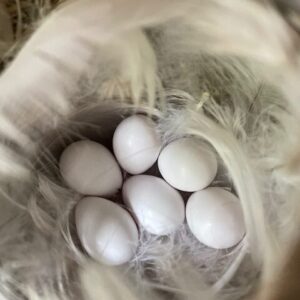
Tree swallow eggs at Oak Point Farm
Many of the migrating species that breed in our area are still active singing and/or calling to attract mates or defend territory. During walks through our preserves we have been hearing at least eleven warbler species on a regular basis, including Yellow, Chestnut-sided, Blackburnian, Black-throated Green, Yellow-rumped, Pine, Black-and-White, American Redstart, Common Yellowthroat, Northern Parula, and Ovenbird. Other migrant species we hear often include Veery, Hermit Thrush, Eastern Phoebe, Blue-headed and Red-eyed Vireos, Eastern Kingbird, and the distinctively-voiced Great Crested Flycatcher. It won’t be too much longer before our woodlands and meadows become quieter as these migrant species begin egg-laying and raising their young. The males who do most, if not all, of the singing will go quiet while the females tend to their eggs and young.
As anticipated, we’ve seen lots of young bluebirds fledging (and getting ready to fledge) on several BRLT preserves. Fifteen new bluebirds fledged last week at Singing Meadows while nine more fledged at Oak Point Farm this past weekend. Ten more are expected to fledge within the next few days—5 at Penny Lake and 5 at Zak. And recall that most bluebirds will raise two broods per season, so there should be many more to come in the months ahead.
Tree Swallows are now incubating anywhere from 5 to 6 eggs in seven different nests on four preserves: Zak (1); Penny Lake (2); Lobster Cove (1); and Oak Point Farm (3). Hatching for these eggs is anticipated in the next week or so.
Although the spring migration is slowing down, the number of recently arrived birds seen and heard on our preserves seems to be nearing an all-time high. Just a few short walks at Singing Meadows, Oak Point Farm, and Lobster Cove last week revealed the presence of many species including: three varieties of vireos, seven varieties of warblers, three varieties of flycatchers, chimney swifts, and broad-winged hawks. This is in addition to the many “usual suspects” we see year-round on our preserves.
One of the most interesting bird observations this past weekend involved a ruby-throated hummingbird and a female tree swallow. The swallow had just taken flight from a nest box at Oak Point when a hummingbird was seen vigorously chasing it at very close range (less than two feet behind). It’s possible the hummingbird had a nest in a nearby tree and was instinctively trying to keep the swallow away from it. You just never know what you’ll see on when you head out to the preserves!
May 15:
The 2024 spring bird migration in Maine is reaching its peak this week and the bluebird breeding season on BRLT preserves is doing very well. Land Trust preserves are alive with birdsong, and avian migrators and residents can be seen with relative ease. My walks through preserves with nest boxes are taking longer since I am stopping frequently to listen to and look for all the new birds in the woods and meadows.
The bluebird population is growing fast on our preserves. Every bluebird egg on our five preserves has now hatched with 52 young bluebirds in various stages of growth. Singing Meadows accounts for almost half of that number with 25 of those new blues. One clutch of 5 youngsters at Singing Meadows will be ready fledge within a week.
Tree swallows are finally getting into the act with a couple of nests now containing eggs. For reasons we are not clear about, tree swallows are using a few nests originally built by bluebirds but not used by them. This is not really a problem since resident bluebirds typically start building nests before tree swallows arrive from their southern wintering grounds.
The annual hawk migration survey on Bradbury Mountain (just west of Freeport) is about to end after 2 months of counting migrating hawks, eagles, & falcons. Broadwing hawks lead all species counted with over 1,400 seen. Turkey vultures (628), sharp-shinned hawks (498), ospreys (429), and American kestrels (314) round out the top five species counted.
May 6:
With the peak of the spring migration in Maine upon us, the number of birds arriving or passing through on their way to breeding grounds further north is increasing by the day. On Friday, May 3, we saw our first Ruby-throated hummingbird of the season at one of our nectar feeders here in East Boothbay, with daily appearances through Sunday. Birds are establishing territories (with song) on land trust properties just about everywhere you look and listen. Our land trust Bluebird nests are filling up with eggs and one of them already has newly-hatched youngsters (Singing Meadows).
We still don’t know how many Bluebird eggs are in the nest box at Penny Lake because the female will not vacate it long enough for our inspector to count them. Since the first 2 eggs were initially deposited on/about April 20, they should be hatching this week. Tree Swallows continue to show interest in the other two nest boxes on the preserve.
Lobster Cove Meadow continues to have only one active Bluebird nest with eggs.
At Zak preserve a nest box that had a nest built by Bluebirds appeared to have been taken over by Tree Swallows, only to have the Bluebirds come back and reclaim it. There were three eggs in that nest this past weekend, so now Zak is at full capacity with two nests containing Bluebird eggs.
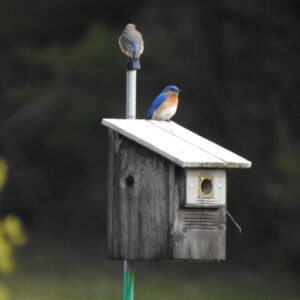
Bluebirds at Zak Preserve

Canada goose family at Oak Point Farm
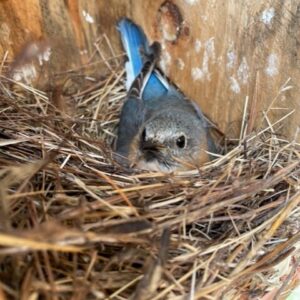
Female Bluebird incubating eggs at Oak Point Farm
We’re not even at the end of April yet, and we currently have at least 44 (and possibly 45) Bluebird eggs in nest boxes on four of our five preserves! The Blues have gotten an early and fast start on their breeding season.
As of this past weekend, Singing Meadows has a whopping 25 eggs being incubated, with 5 eggs in each of 5 different nest boxes. We’ve never seen those numbers in the many years we’ve been doing this.
Oak Point Farm is off to a slightly slower start with at least 9 Bluebird eggs in 2 different nest boxes. There may actually be 10 eggs but one stubborn female Blue refused to let us count how many eggs she’s incubating.
Zak had 5 eggs in one nest box, and Lobster Cove Meadow also had 5 eggs in one nest box.
Tree Swallows have laid claim to three nest boxes (one each at Penny Lake, Zak, & Oak Point Farm) but they have not deposited any eggs in any of those boxes. That should change this week.
The spring migration is ramping up quite nicely with peak migration for Maine still about a week or two away. Lots of the usual suspects of many varieties are being seen in steadily increasing numbers (including warblers, flycatchers, sparrows, hawks, herons, etc.). The folks who count migrating raptors during the spring at Bradbury Mountain State Park are reporting significant numbers of Broad-winged Hawks (over 1,100), Ospreys (over 380), Sharp-shinned Hawks (over 350), and American Kestrels (over 290) so far.
Our preserves are also coming alive with the sounds of birds calling and establishing breeding territories. An app for your smart phone from Cornell University (Merlin Bird ID) can help you identify most of the birds you’re hearing but cannot find. The app can also help you identify many birds by their relative size, color, and behavior. The app is free and can really help you enjoy our preserves even more.
For those who like to provide nectar for Hummingbirds, now would be a good time to clean those feeders, fill them with nectar (4 parts water, 1 part granulated sugar), and get them hung where these flying gems can find them. They should start showing up here in the Midcoast in the next week or two. Please be sure to keep those feeders clean throughout the season.
With the weather improving every day, now is a great time to get out on our land trust preserves and see what’s happening!
The bird breeding season and the spring migration are picking up speed! Since last week, we saw an uptick in the number of bluebird eggs deposited in nests on four (out of five) of our land trust preserves. Furthermore, the number and variety of migrating birds we’re seeing is growing daily.
Four of six nest boxes at Singing Meadows have bluebird eggs in them. Zak Preserve doesn’t have any eggs yet but that will likely change this week with bluebirds in one nest box and tree swallows in the other. Penny Lake has bluebird eggs in one of three nest boxes and tree swallows are likely to deposit eggs in another. Two of the five nest boxes at Oak Point Farm have bluebird eggs in them with tree swallows possibly preparing to deposit eggs in one other. One of two Lobster Cove Meadows nest boxes now has 4 bluebird eggs in it with tree swallows possibly preparing to do the same in the second box.
You may recall that tree swallows, like bluebirds, are cavity-nesting birds so the nest boxes on our preserves are attractive to them for breeding. Accordingly, it’s not unusual to see this “sharing” of nest boxes between the two species. By the way, we can tell which nest boxes are being used by Tree Swallows even before they deposit their white eggs: they typically line their nests with feathers while the bluebird’s blue eggs are deposited in grass-lined nests. Although we might prefer to see bluebirds nesting in ALL the nest boxes, we are “equal opportunity” bird landlords, so we do not object to (nor do we evict) tree swallows using the nest boxes.
Inspection of nest boxes last week on five BRLT preserves indicates that our Bluebirds have been very busy. All five preserves had at least one nest completely built and one nest (at Singing Meadows) even had three eggs in it! Many of the nest boxes on our preserves had early signs of Bluebird nest construction, but there were several with completed nests that appeared ready to have eggs deposited in them. Good weather over the past several days will have provided the Blues with the opportunity to finish nest building and get on with the business of egg-laying. We anticipate that inspections this week will reveal many more completed nests with eggs in several of them. Stay tuned!
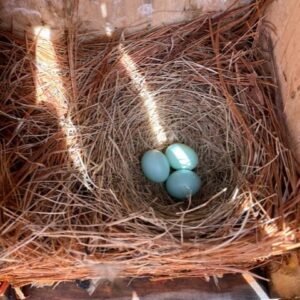
The first Bluebird eggs of the season on a BRLT preserve
We’re now into week 2 of this season’s bird breeding activity, and we’ve seen evidence of nest building on four of five BRLT preserves.
Singing Meadows has one nest box with Bluebird nest building in progress, while a second nest box has very early evidence of a different species building a nest. We should know more about this by next week.
Lobster Cove Meadow has a completed Bluebird nest in one nest box while the other box is still empty.
Oak Point Farm has one nearly complete Bluebird nest in one of five nest boxes.
Both nest boxes at Zak preserve are showing evidence of Bluebird nest building.
All three nest boxes at Penny Lake remain empty, but we don’t expect that to last long.
Bluebirds have been seen at all five preserves and appear to be ready to add nests to more nest boxes and even begin to deposit sky-blue eggs in at least two nests within the next few days. Stay tuned — we’re just getting started!
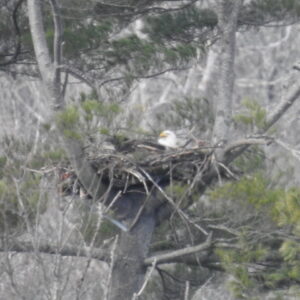
Female Bald Eagle on nest March 16, 2024


